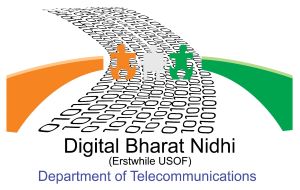BharatNet Phase-I:
The Union Cabinet on 25.10.2011 approved the project for the creation of the National Optical Fibre Network (NOFN, now BharatNet) to provide broadband connectivity at the Gram Panchayat (GP) level by connecting block headquarters (BHQs) to GPs by using existing fibre of Central Public Sector Undertakings (CPSUs) such as Bharat Sanchar Nigam Limited (BSNL), RailTel Corporation of India Limited (RailTel) and Power Grid Corporation of India Limited (PGCIL) and laying incremental fibre to bridge the connectivity gap up to the GPs. The Government owns the incremental Optical Fibre Cable (OFC), and the ownership of the existing fibre was to be continued to be vested with the current owners. This was considered Phase-I of BharatNet.
Phase-I was completed in December 2017 with implementation in over 1 lakh GPs. Subsequently, the scope of Phase-I was expanded to 1.25 lakh GPs (Revised work front Phase-I) as per the Cabinet approval of 19.07.2017.
BharatNet Phase-II:
The Cabinet approved a modified strategy for BharatNet on 19.07.2017, which integrates the implementation experience of Phase-I of the project and aligns it with the vision of Digital India. The modified strategy provides an optimal mix of media (OFC, Radio and satellite) to connect Gram Panchayats (GPs). Under Phase II, GPs are to be connected through multiple implementing models like State-led Model, Private Sector Model and CPSU Model, along with Last Mile connectivity in GPs through Wi-Fi or any other suitable broadband technology. Various States covered under different models of Phase II are:
- State-Led Model: 8 states are being implemented under this model. Chhattisgarh, Gujarat, Jharkhand, Andhra Pradesh, Maharashtra, Odisha and Telangana are at various stages of implementation.
- CPSU-Led Model: Under this model, BSNL is executing works in four states and union territories. Madhya Pradesh, Uttar Pradesh and Sikkim are at various stages of implementation.
- Private Led Model: Punjab and Bihar have implemented the private sector model directly by BBNL. Work has almost been completed in both states.
- Satellite: The satellite component of Phase II is being implemented by BBNL and BSNL. BSNL is implementing 1408 GPs and BBNL is implementing 3753 GPs.
The utilisation of BharatNet network:
The utilisation of the network is through leasing bandwidth and dark fibre, Wi-Fi to access broadband or internet services in public places, and Fibre to the Home (FTTH).
As part of the project, the Last Mile Connectivity (LMC) to access broadband or internet services is to be provided through Wi-Fi in public places or any other suitable broadband technology, including FTTH at Government institutions such as schools, hospitals, post offices, anganwadis, police stations, etc.
The BharatNet tariff details are available at http://www.bbnl.nic.in/index1.aspx?lsid=673&lev=2&lid=538&langid=1.
The total funding of the BharatNet (Phase-I and Phase-II), approved by the Cabinet, is Rs 42,068 crores (exclusive of GST, Octroi and local taxes).
As on 31.12.2023, a total of Rs. 39,825 crore has been disbursed under BharatNet Project since inception of the project.
The State/UT-wise details of Gram Panchayats made service ready under BharatNet Project during last five years are given in Annexure-I.
Annexure-I - The State/UT-wise details of Gram Panchayats made service ready under BharatNet Project during last five years.
| S. No. | Name of States/UTs | Service Ready GPs |
| 1 | Assam | 15 |
| 2 | Bihar | 2791 |
| 3 | Chhattisgarh | 5567 |
| 4 | Haryana | 13 |
| 5 | Jammu & Kashmir | 446 |
| 6 | Karnataka | 4 |
| 7 | Kerala | 1 |
| 8 | Madhya Pradesh | 5290 |
| 9 | Maharashtra | 8975 |
| 10 | Punjab | 4781 |
| 11 | Rajasthan | 418 |
| 12 | Uttar Pradesh | 13921 |
| 13 | Uttarakhand | 383 |
| 14 | West Bengal | 554 |
| 15 | Sikkim | 22 |
| 16 | Chandigarh | 0 |
| 17 | Lakshadweep | 9 |
| 18 | Arunachal Pradesh | 859 |
| 19 | Nagaland | 134 |
| 20 | Manipur | 1151 |
| 21 | Mizoram | 420 |
| 22 | Tripura | 225 |
| 23 | Meghalaya | 495 |
| 24 | Gujarat | 8885 |
| 25 | Daman & Diu | 3 |
| 26 | Dadra & Nagar Haveli | 0 |
| 27 | Puducherry | 0 |
| 28 | Andhra Pradesh | 3811 |
| 29 | Telangana | 7414 |
| 30 | Odisha | 3258 |
| 31 | Jharkhand | 2096 |
| 32 | Himachal Pradesh | 186 |
| 33 | Ladakh | 142 |
| 34 | Goa | 0 |
| 35 | Tamil Nadu | 1922 |
| 36 | Andaman & Nicobar | 72 |
| Total | 74263* |
* Total 2,10,100 GPs has been made service ready till 15-01-2024. For more details, visit: https://bbnl.nic.in/.
State /UT-wise details of fund disbursed as on 31.12.2023 under BharatNet
| S.No. | Name of States/UT | Total |
| 1 | Andaman & Nicobar | 24.02 |
| 2 | Assam | 288.37 |
| 3 | Bihar | 1609.50 |
| 4 | Chandigarh | 0.82 |
| 5 | Chhattisgarh | 2635.75 |
| 6 | Haryana | 639.56 |
| 7 | Jammu & Kashmir | 259 |
| 8 | Karnataka | 1336.59 |
| 9 | Kerala | 206.07 |
| 10 | Maharashtra | 5475.29 |
| 11 | Madhya Pradesh | 3951.03 |
| 12 | Punjab | 1330.22 |
| 13 | Rajasthan | 1825.26 |
| 14 | Uttar Pradesh | 5331.15 |
| 15 | Uttarakhand | 348.54 |
| 16 | West Bengal | 641.43 |
| 17 | Sikkim | 87.96 |
| 18 | Puducherry | 9.17 |
| 19 | Gujarat, D & N, Daman & Diu | 3671.50 |
| 20 | Lakshadweep | 0.22 |
| 21 | Telangana | 2144.81 |
| 22 | Odisha | 1308.69 |
| 23 | Jharkhand | 978.88 |
| 24 | Himachal Pradesh | 123.30 |
| 25 | Andhra Pradesh | 1570.57 |
| 26 | Tamilnadu | 815.62 |
| 27 | Ladakh | 0.69 |
| 28 | NE-I (Meghalaya, Mizoram and Tripura) | 274.72 |
| 29 | NE-II (Arunachal Pradesh, Manipur and Nagaland) | 335.88 |
| 30 | Other Miscellaneous expenses | 2600.73 |
| Total | 39825.34 | |
Note: As on 31-12-2023, Rs. 39,825.34Cr has been disbursed from USOF under BharatNet.
District-wise implementation status of BharatNet in Jharkhand
| S. No. | District | Service Ready GPs (Ph-I + Ph- II) | GPs to be covered in Amended BharatNet Program |
| 1 | BOKARO | 251 | |
| 2 | CHATRA | 152 | |
| 3 | DEOGHAR | 193 | 1 |
| 4 | DHANBAD | 256 | |
| 5 | DUMKA | 206 | |
| 6 | EAST SINGHBUM | 226 | 3 |
| 7 | GARHWA | 189 | |
| 8 | GIRIDIH | 357 | 1 |
| 9 | GODDA | 201 | |
| 10 | GUMLA | 159 | |
| 11 | HAZARIBAGH | 254 | 3 |
| 12 | JAMTARA | 118 | |
| 13 | KHUNTI | 86 | |
| 14 | KODERMA | 109 | |
| 15 | LATEHAR | 109 | 5 |
| 16 | LOHARDAGA | 64 | 2 |
| 17 | PAKUR | 128 | |
| 18 | PALAMU | 281 | |
| 19 | RAMGARH | 142 | 1 |
| 20 | RANCHI | 301 | 4 |
| 21 | SAHEBGANJ | 163 | 3 |
| 22 | SARAIKELA KHARSAWAN | 132 | |
| 23 | SIMDEGA | 94 | |
| 24 | WEST SINGHBHUM | 217 | |
| Total | 4,388 | 23 |








